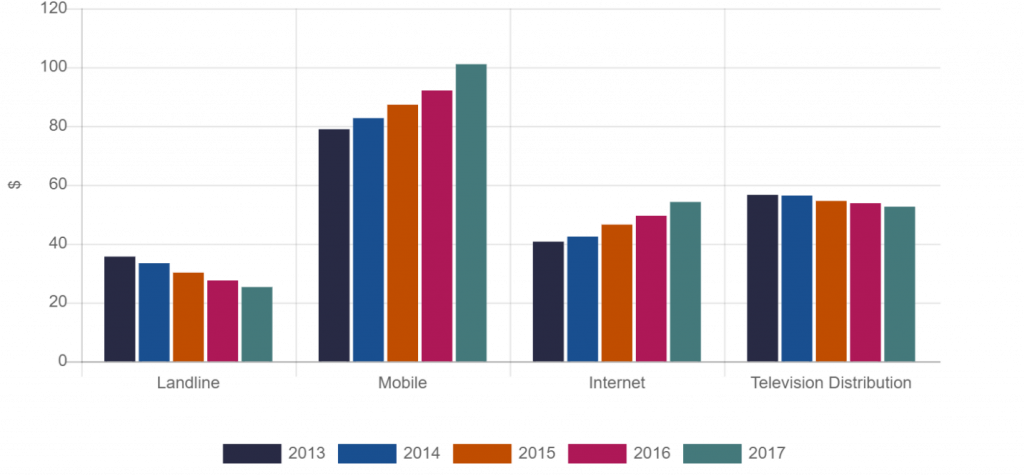3: Digital technology is transforming consumption

Contents
- Introduction
- 1: Growth or “slowth”
- 2: Digital technology is transforming production and labour
- 3: Digital technology is transforming consumption
- 4: Digital technology is transforming trade
- 5: Digital technology is transforming the nature of ownership and expectations of value generation
- 6: Digital technologies impact financial market behaviours
- 7: Digital technology blurs the interpretive function of key macroeconomic indicators
- 8: Digital technologies impact official data and macroeconomic policy tools
- Acknowledgments
Digital technology is transforming consumption
Digital technology continues to advance at an unprecedented rate. The effect of the technological advances on consumption results in various scenarios. Current market trends, supporting increased consumer demands, balloon. Goods and services are cheap to produce and demand is insatiable. Technological advances have added value to existing products and services and enabled the creation of new ones, thereby also increasing consumption. These trends serve to increase gross domestic product (GDP). Alternatively, advances in digital technology consumption may decrease if new technology replaces an existing product or service at a lower cost, if consumers can repurpose durable goods or if consumers delay purchases. Consumer welfare could improve even as GDP declines.
Between 2013 and 2017, Canadian spending on mobile and Internet services increased by approximately 27 percent and 33 percent, respectively.1 During the same period, combined spending on landline and television distribution services decreased by approximately eight percent.

Increasing household consumption
The single largest economic driver of GDP is generated through household consumption, accounting for 58 percent in 2018 in Canada. Consequently, changes to household consumption by digital technologies is particularly interesting to examine. Technological changes may affect consumption patterns, perhaps increasing or decreasing those patterns through their impact on utility, investment, and job creation. These changes may expand opportunities that were previously non-existent or generate more variable and uncertain incomes. The result of the uncertain or enhanced investment and job creation opportunities may serve to either increase or decrease GDP.
Enhancing utility
Digital technology allows people to earn income from assets that were previously difficult to market by reducing transactional friction. For example, spare rooms can be rented out via Airbnb, and idle automobiles can generate income for drivers through Uber or Lyft. This reduced transactional friction enhances the utility of existing assets and serves to expand markets by reducing costs and improving access. However, it is unclear whether this new demand would result in a net increase to GDP. As a secondary effect, new entrants may reduce previous spending on hotels, taxis, and delivery services. This would force these providers to lower their prices. People affected by these markets may experience ups and downs in terms of both how much they earn, and how often they earn it. The uncertainty around purchasing and investment decisions, be it perceived or real, will have a negative impact on GDP.
Shifting from physical to digital
Digital technology allows the delivery of some goods and services to shift from physical to digital form. Digital delivery of everything from music and journalism to movies brings the cost of providing an additional unit to, or near to, zero.
The net effect of this shift on GDP is unclear and results in various futures.
In one scenario, within competitive markets, new entrants will contribute additional supply and lower per-unit prices, which will further encourage consumption. The new entrants will provide a net increase to jobs. The job growth leading to potential increase in purchasing power due to lower prices may increase consumption and therefore GDP.
In another scenario, if the market is already saturated, no additional entrants will join. And although per-unit prices may fall, without the associated job growth, consumption will not change. GDP could still fall as people buy cheaper substitutes within the digital space. However, in the absence of a competitive market, the benefits from cheaper production might not be passed on to consumers as lower prices. In this future, wages may go down, but prices do not, leading to stagnant or falling GDP.
Beyond these two futures, the following trends emerge:
- New market models may shift demand without producing clear pricing signals that are associated with the shift. A service may be offered in exchange for something that is not priced, such as digital data. A company uses data to deepen and broaden markets, whereas governments can use data to make public services more efficient or accessible. Whether digital data encourages or discourages demand as measured by GDP depends on how insights from data are used.
- Digital technology is transforming public service provision and use. For example, the City of Innisfil, Ontario (population 36,000) partnered with Uber3 to provide more public transit to its residents.
Public-private technology partnerships can increase demand in many ways. These range from shifting demand from a non-profit to a for-profit market structure, to enhancing provision of affordable high-quality public services. It is also unknown whether these developments will increase or decrease the base cost of service. Prices are a function of the contracts negotiated on behalf of consumers, citizens, and residents.
Repurposing durable goods
Durables such as smart appliances and automobiles can increasingly be “repurposed” without replacing hardware. A digitally controlled physical item, such as a smartphone, can be repurposed to perform the functions of multiple pieces of hardware. Simply changing its software, for example, could turn the smartphone into a compass, a map, a camera, a television, a typewriter, and a keyboard. Other examples include reprogrammable assembly robots and 3D printers.
More repurposing may reduce consumer spending, which in turn would reduce GDP. Buying one smartphone or robot can eliminate the need to buy several other products. Manufacturers of multi-purpose products can still create new demand. However, a world in which consumers need fewer items, repurposing, or upgrading them, and keeping them for longer, would likely result in a negative impact on GDP. This is true even if people consume the same, or more, things.
Delaying consumption
Consumers may put off purchases as they wait for the next “smart” product to become available. For example, consumers would traditionally choose to buy or replace a conventional internal combustion engine car reaching the end of its lifespan. However, electric vehicles are poised to become cheaper to buy and operate. As a result, consumers may delay buying a vehicle until they can compare the merits of both types. More smart features may not drive new sales. As smart devices include more features, the marginal utility of additional products tends to diminish. This dampens demand for replacement items. Free upgrades through new software may become more widely available, making it easier or more intuitive to enhance current capacity.
Endnotes
1 Statistics Canada Survey of Household Spending, accessed April 29, 2020, https://crtc.gc.ca/eng/publications/reports/policyMonitoring/2019/cmr1.htm
2 “Canada: Household consumption, percent of GDP, “ The Global Economy, accessed March 2020, https://www.theglobaleconomy.com/Canada/household_consumption/
3 Laura Bliss, “Uber was Supposed to be Our Public Transit,” Citilab, last accessed April 29, 2018, https://www.bloomberg.com/news/articles/2019-04-29/when-a-town-takes-uber-instead-of-public-transit